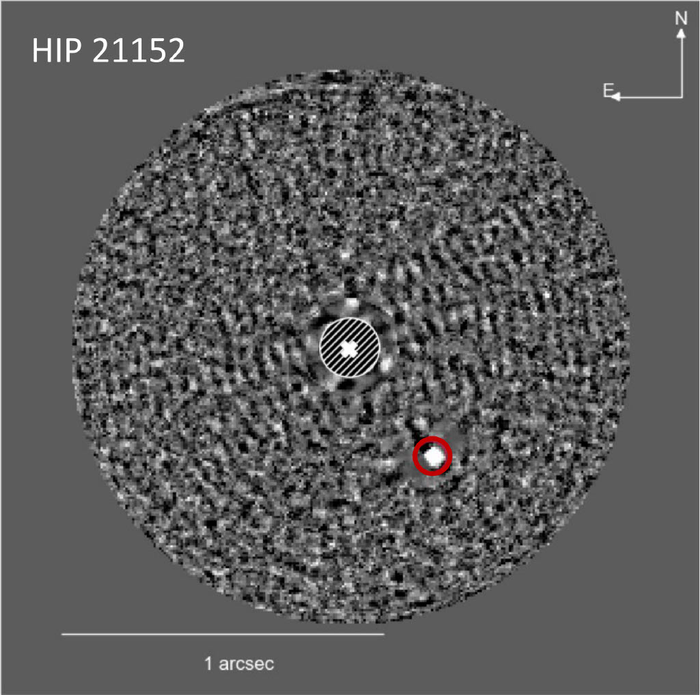Reviewed by Alex SmithJun 10 2022
Brown dwarfs are enigmatic astronomical objects that straddle the line between the heaviest planets and the smallest stars, with both stellar and planetary features. These perplexing objects are important for improving the understanding of both stars and large planets because of their hybrid character.
 Image of the brown dwarf (in the red circle) discovered around the star HIP 21152, obtained with the Very Large Telescope SPHERE instrument. Image Credit: © M. Bonavita et al., MNRAS, July 2022, https://doi.org/10.1093/mnras/stac1250
Image of the brown dwarf (in the red circle) discovered around the star HIP 21152, obtained with the Very Large Telescope SPHERE instrument. Image Credit: © M. Bonavita et al., MNRAS, July 2022, https://doi.org/10.1093/mnras/stac1250
Brown dwarfs circling a parent star from a suitably remote distance can be photographed directly, unlike those orbiting too near to their star and being obscured by its brilliance. This gives scientists a once-in-a-lifetime chance to investigate the chilly, planet-like atmospheres of brown dwarf companions.
Despite significant progress in the development of new observing methods and image processing algorithms, direct detections of brown dwarf companions to stars have remained quite sparse, with only roughly 40 systems observed in nearly three decades of studies.
According to a study published in the journal Monthly Notices of the Royal Astronomical Society MNRAS, scientists led by Mariangela Bonavita of the Open University and Clémence Fontanive of the Center for Space and Habitability (CSH) and the NCCR PlanetS at the University of Bern imaged four new brown dwarfs. Numerous new systems with brown dwarf companions on large orbital separations have been released at the same time for the first time.
Innovative Search Method
Wide-orbit brown dwarf companions are rare to start with, and detecting them directly poses huge technical challenges since the host stars completely blind our telescopes.
Mariangela Bonavita, Scientist, Open University
The majority of previous surveys have been based on randomly selecting stars from nascent clusters.
An alternative approach to increase the number of detections is to only observe stars that show indications of an additional object in their system.
Clémence Fontanive, Scientist, Center for Space and Habitability
The way a star moves under the gravitational attraction of a companion, whether it is a star, a planet, or something in between, can reveal its presence.
“We developed the COPAINS tool which predicts the types of companions that could be responsible for observed anomalies in stellar motions,” Clémence Fontanive continues.
Based on data from the European Space Agency’s Gaia probe, the study team carefully picked 25 nearby stars that were suitable for the direct identification of hidden, low-mass companions using the COPAINS instrument (ESA).
They successfully found ten new companions with orbits spanning from Jupiter to beyond Pluto, comprising five low-mass stars, a white dwarf (a dense stellar remnant), and, surprisingly, four new brown dwarfs, using the SPHERE planet-finder at the Very Large Telescope in Chile.
A Major Boost in Detection Rate
These findings significantly advance the number of known brown dwarfs orbiting stars from large distances, with a major boost in detection rate compared to any previous imaging survey.
Mariangela Bonavita, Scientist, Open University
While this technique is now restricted to brown dwarf and stellar companions, future phases of the Gaia project will push these techniques to lower masses, allowing the finding of additional large exoplanets.
Clémence Fontanive further adds, “On top of having so many discoveries in one go, our program also demonstrates the power of these search strategies.”
“This result was only possible because we believed that, when combining space and ground-based facilities to directly image exoplanets, the whole is greater than the sum of its parts. We hope that this will be the start of a new era of synergy between different instruments and detection methods,” Mariangela Bonavita concludes.
Journal Reference:
Bonavita, M., et al. (2022) Results from The COPAINS Pilot Survey: four new BDs and a high companion detection rate for accelerating stars. Monthly Notices of the Royal Astronomical Society. doi.org/10.1093/mnras/stac1250.